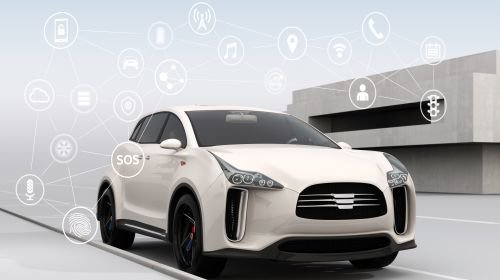
28/03/2018
Standard or retrofit ADAS systems, the aftermarket grappling with sensor and camera calibrations
Dino Collazzo
The multiplication of safety systems such as cruise control, forward collision warning and traffic sign recognition will inevitably lead to more maintenance work. But servicing a "smart" vehicle is anything but simple, it requires specific skills and equipment.
Safer vehicles and no more accidents. This is the challenge facing Advance driver assistance system (Adas) on which the automotive industry as a whole is creating a new set of business strategies. Systems like cruise control, forward collision warning, traffic sign recognition or lane departure warning systems, just to name a few, are spreading rapidly and will soon no longer be just optional. In fact, the European Parliament has recently approved a proposal to make some ADAS systems mandatory on all new production models.
Considering this scenario, the aftermarket sector can hardly afford to just stand around looking: merely observing the changes without interacting with them. The garage sector especially will be called upon to deal with increasingly sophisticated vehicles. Workshops will have to provide adequate assistance to cars equipped with software, cameras, radars and sensors, all with timely and precise maintenance work. And to do this, repairers should have developed new technical skills and acquired new and innovative diagnostic tools.
In Italy, according to recent estimates, cars with advanced driver assistance systems are around 4%. A figure destined to grow rapidly in 2018, so much so that several analysts are now speaking of a market share of about 40%. The multiplication of ADAS systems will bring a greater number of maintenance interventions along with it. But servicing a car with "smart" safety systems is anything but simple. Even replacing ordinary parts such as windscreens, headlights, rear-view mirrors or other parts of the vehicle equipped with sensors, will require more attention. In fact, once the work is done, it will be necessary to calibrate the sensors and the cameras installed. And to do this specific kits – made up of metric mats, panels and other accessories - will be necessary to cater for each model and brand. Investing in these tools, as well as training, is therefore essential if one wants to still have a future in this field. But business opportunities certainly do not stop here. In addition to “routine” assistance, the market offers retrofit opportunities for cars, buses and commercial vehicles that have been in circulation for several years now: basically a technological upgrade. In the United States as well as the U.K., some companies have already been experimenting with the possibility of installing, on older buses and commercial vehicles, software and cameras to improve safety. We are talking about systems able to warn drivers, by means of acoustic signals, of possible collisions with pedestrians, cyclists or other vehicles, or failure to observe safety distance, speed limits or accidentally crossing onto a different lane. The introduction of these innovations, whether as standards or retrofits, is aimed at improving road safety and eliminating the main causes of road accidents.
In Europe, according to the latest data provided by the EU Commission, the number of accidents has dropped significantly in recent years. And this thanks to more stringent road-check policies and the growing popularity of advanced safety systems. In 2016, fatal accidents fell by 2%, even though the number of victims remained high: 25,500 deaths and 135 thousand serious injuries. Most of the accidents, 55%, occurred on country roads, followed by urban areas, 37% and motorways, 8%. The majority of the victims are car occupants (46%). But if we add together pedestrians (21%), cyclists (8%) and motorcyclists (14%), considered the most vulnerable road users, the proportion is almost the same. Shocking figures indeed, yet still positive compared to ten years earlier. In fact, from 2006 to 2016 the accident rate decreased by 19.6% while the number of victims fell by 41.6% (43.700 in 2006). But all this is still not enough. In fact, the challenge for the automotive world, in its entirety is: zero accidents. Most of the hopes rest on the success of totally autonomous vehicles in the future.
Considering this scenario, the aftermarket sector can hardly afford to just stand around looking: merely observing the changes without interacting with them. The garage sector especially will be called upon to deal with increasingly sophisticated vehicles. Workshops will have to provide adequate assistance to cars equipped with software, cameras, radars and sensors, all with timely and precise maintenance work. And to do this, repairers should have developed new technical skills and acquired new and innovative diagnostic tools.
In Italy, according to recent estimates, cars with advanced driver assistance systems are around 4%. A figure destined to grow rapidly in 2018, so much so that several analysts are now speaking of a market share of about 40%. The multiplication of ADAS systems will bring a greater number of maintenance interventions along with it. But servicing a car with "smart" safety systems is anything but simple. Even replacing ordinary parts such as windscreens, headlights, rear-view mirrors or other parts of the vehicle equipped with sensors, will require more attention. In fact, once the work is done, it will be necessary to calibrate the sensors and the cameras installed. And to do this specific kits – made up of metric mats, panels and other accessories - will be necessary to cater for each model and brand. Investing in these tools, as well as training, is therefore essential if one wants to still have a future in this field. But business opportunities certainly do not stop here. In addition to “routine” assistance, the market offers retrofit opportunities for cars, buses and commercial vehicles that have been in circulation for several years now: basically a technological upgrade. In the United States as well as the U.K., some companies have already been experimenting with the possibility of installing, on older buses and commercial vehicles, software and cameras to improve safety. We are talking about systems able to warn drivers, by means of acoustic signals, of possible collisions with pedestrians, cyclists or other vehicles, or failure to observe safety distance, speed limits or accidentally crossing onto a different lane. The introduction of these innovations, whether as standards or retrofits, is aimed at improving road safety and eliminating the main causes of road accidents.
In Europe, according to the latest data provided by the EU Commission, the number of accidents has dropped significantly in recent years. And this thanks to more stringent road-check policies and the growing popularity of advanced safety systems. In 2016, fatal accidents fell by 2%, even though the number of victims remained high: 25,500 deaths and 135 thousand serious injuries. Most of the accidents, 55%, occurred on country roads, followed by urban areas, 37% and motorways, 8%. The majority of the victims are car occupants (46%). But if we add together pedestrians (21%), cyclists (8%) and motorcyclists (14%), considered the most vulnerable road users, the proportion is almost the same. Shocking figures indeed, yet still positive compared to ten years earlier. In fact, from 2006 to 2016 the accident rate decreased by 19.6% while the number of victims fell by 41.6% (43.700 in 2006). But all this is still not enough. In fact, the challenge for the automotive world, in its entirety is: zero accidents. Most of the hopes rest on the success of totally autonomous vehicles in the future.








